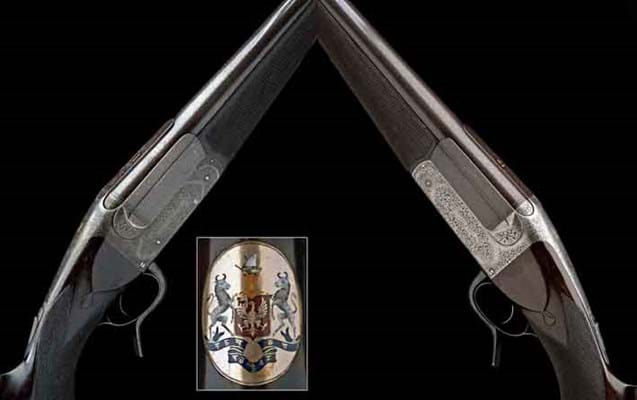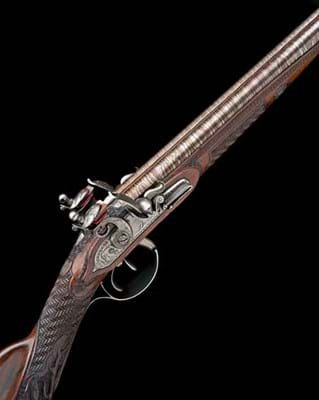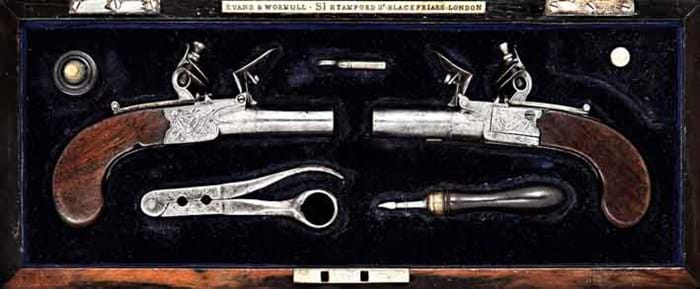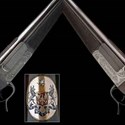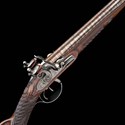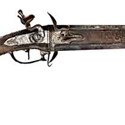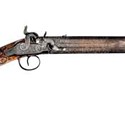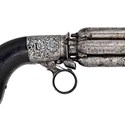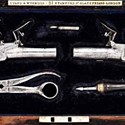Offered on September 20 were a pair of massive four-bore wildfowling guns built for the Maharajah of Bhavnagar by H. Clarke & Sons of the Midland Gun Works, Leicester, were reunited for the first time in several generations.
The two single-barrelled guns, each of which weighed in at 14lb 13oz (6.75kg), came to the saleroom from two different vendors, having had very different histories since they were last together.
The first was mounted with an enamelled gold escutcheon on the comb of the stock emblazoned with the maharajah's arms and was further adorned with a medallion indicating that it was from the collection of one of England's best-known collectors, William Keith Neal. He apparently acquired the gun in the 1960s and despite its weight and provenance regularly used it to shoot geese in Scotland until he was in his 70s.
The second was discovered by its vendor in the gunroom at Holland & Holland's Bruton Street showrooms in London in the 1980s where the quality of its manufacture shone through despite the fact that it was minus its stock and without any finish on the metalwork.
These deficiencies were put right by Hollands (at the cost of a king's ransom, reported the vendor) and the gun spent the next 20 years in South Australia. When it finally appeared in the saleroom alongside its long-lost companion it was therefore refinished and had a non-original stock without the Maharajah's escutcheon.
It had long been the dream of the vendor of this second gun to reunite the pair and the stage was finally set last month. The main battle was for the first gun with its powerful combined provenance and original stock. Once this had been bought for £21,000, the same buyer was able to take the second for £10,000.
There will presumably now be a period of intensive training for both shooter and loader if these 36in (91cm) barrelled heavyweights are once again to be used as a true pair.
The princely selection also included a Rigby 7x65R sidelock ejector double rifle built in 1907 for the Maharana of Udaipur which sold for £15,000 and an Alexander Henry .360 black powder double rifle completed for the Maharaj of Dholpur in 1902 which took £4200.
However, most princely of all proved to be an exceptionally well-preserved 10-bore sidelock ejector made by Charles Lancaster in 1910 for the Maharajah of Patiala, a notably lavish and flamboyant ruler in an age when there was no shortage of free-spending princes from the east patronising the best English makers of everything from cars to guns.
Retaining much of its original finish and inscribed MADE SPECIALLY FOR H.H. THE MAHARAJAH SAHIB BHUPINDER SINGH OF PATIALA, this gun reached £31,000.
The name of William Keith Neal also drew extra attention to a group of five 18th and 19th century Continental shoulder guns from his collection which appeared earlier in Holt's sale. The prettiest of these was the 25-bore flintlock double-barrelled sporting gun made by Dolne of Liege for Prince Friedrich Wilhelm Ludwig of Prussia, which made £6500.
The buyer's premium was 22.5%.
Fine French Arms
France provided the noble provenances for the major lots in the arms and armour sale atChristie's South Kensingtonon September 26.
Top of the tree was a very high quality sabre that once belonged to Charles Ferdinand d'Artois, duc de Berry, son of Charles X and heir to the Bourbon throne when he was stabbed and killed outside the opera in 1820.
Following Napoleon's escape from Elba, Charles Ferdinand briefly commanded the army in 1815 and the sabre on offer at Christie's was dated to the period 1815-20.
It was the product of the Manufacture Royal du Klingenthal and bore the signature of Père Bick, one of the best makers of the time. Complete with its original scabbard, it was estimated at £80,000-100,000 and sold for £70,000.
There was also interest in a group of mainly 18th century sporting guns from the family collection of the ducs de Luynes, which were of interest for their technical complexity as well as their noble origins. A royal coat-of-arms engraved on the lock plate indicated that a 20-bore double-barrelled flintlock by Pierre de Sainte of Versailles had been originally made for a member of the French royal family.
This gun was also technically interesting in that it had rotating turnover barrels. It was not in perfect condition but its overall quality and provenance saw it sell for £12,000.
Turnover barrels were also a feature of two German 25-bore flintlock rifled carbines for boar shooting by Wilhelm Linden Schmitt of Mainz. These differed in detail but were close enough to be considered a near pair and sold for £4500.
A very different approach to multiple shots was demonstrated by another short boar-hunting rifle from the de Luynes family: an 18-bore double barrelled percussion carbine by La Page of Paris, c.1840. This was of high quality and contrived to fire four shots from the two barrels by loading each barrel with two charges, one in front of the other. These were fired by four hammers operated by a single trigger. Superimposed load rifles of such quality are rare and this example sold for £8500.
There was a monster lurking in the South Kensington sale in the form of a two-bore flintlock fowling gun by Howell, c.1820-30.
Though it was stocked in conventional fashion, it has to be assumed that with barrels over 4ft (1.22m) long this weapon was never intended to be fired from the shoulder and the auctioneers noted that the underside of the butt was slotted, probably from being mounted in a punt. It sold at £5500.
The buyer's premium was 25/20/12%.


